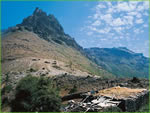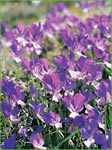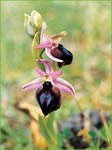 The main peaks of Mount Ochi are Profitis Ilias (1,399m) and Giouda, (1,386m), two enormous castle-like amphibolite and dark slate rock formations hewn by natural erosion. Between the peaks of Giouda and Boublia (1,227m) is a deep ravine that cuts between the northern parts of Mount Ochi to form the Dimosaris Gorge. The northern side of the mountain has steep forested slopes and lush ravines that drop abruptly into the sea. The southern slopes towards Karistos are gentle with limestone rock ridges protruding at intervals, and bring to mind the smooth geographic relief of the Cyclades. The main peaks of Mount Ochi are Profitis Ilias (1,399m) and Giouda, (1,386m), two enormous castle-like amphibolite and dark slate rock formations hewn by natural erosion. Between the peaks of Giouda and Boublia (1,227m) is a deep ravine that cuts between the northern parts of Mount Ochi to form the Dimosaris Gorge. The northern side of the mountain has steep forested slopes and lush ravines that drop abruptly into the sea. The southern slopes towards Karistos are gentle with limestone rock ridges protruding at intervals, and bring to mind the smooth geographic relief of the Cyclades.
 The Ochi region lies between two seas: the Euboean Gulf in the south and west – a large, protected expanse with relatively shallow waters - and the Kavontoros of the Aegean Sea with its strong currents and deep waters right to the shoreline. The Ochi region lies between two seas: the Euboean Gulf in the south and west – a large, protected expanse with relatively shallow waters - and the Kavontoros of the Aegean Sea with its strong currents and deep waters right to the shoreline.
Mount Ochi is beautiful in autumn, especially in October, when autumn flowers such as the autumn crocus, cyclamens, and narcissi begin to bloom and infuse the air with their distinct intoxicating aroma. Southbound migrating birds pass through the region during the same period.
 Die Specific habitat combinations sustain a large variety of flora and fauna. The Ochi region is home to the largest concentration of male peonies in Greece and to an assortment of rock plants, several endemic to Euboea and Greece. Seven plant species endemic to Euboea grow in southern Karistos. The peaks of the mountain have blended myth and wild nature in a singular way. The love-affair of Hera and Zeus hovers over Drakospito. A later legend describes an enormous dragon, which lived on the peak and whose footprints can be seen pressed into the rocks. The peaks have always been places of worship and adoration – to Hera in the past, to Profitis Ilias today.
The peaks are still a place of adoration for many nature-lovers. From this natural balcony on a clear day, you can see even the mountains of Chios, Samos, and Peloponnesos.
Die Specific habitat combinations sustain a large variety of flora and fauna. The Ochi region is home to the largest concentration of male peonies in Greece and to an assortment of rock plants, several endemic to Euboea and Greece. Seven plant species endemic to Euboea grow in southern Karistos. The peaks of the mountain have blended myth and wild nature in a singular way. The love-affair of Hera and Zeus hovers over Drakospito. A later legend describes an enormous dragon, which lived on the peak and whose footprints can be seen pressed into the rocks. The peaks have always been places of worship and adoration – to Hera in the past, to Profitis Ilias today.
The peaks are still a place of adoration for many nature-lovers. From this natural balcony on a clear day, you can see even the mountains of Chios, Samos, and Peloponnesos.  Like giant stone castles, the peaks watch over the gorges and the sea. South of Profitis Ilias is a cluster of peaks called Neraida, a stone desert of bare rocky ridges where you can find rare rock formations of geological interest. Vertical rock formations seem to sway slowly in the burning summer sun. At sunrise, the peaks are steamy as they peek out of the clouds rolling in from the north. In winter, they appear through the fog like mirages. The rocks on the peaks are dark amphibolite, an unusual type of slate. A lava-like black-green rock called serpenite can also be found here. The peaks of Mount Ochi are of the few places in southern Greece with these types of rock formations, and exceptional geological monuments. Like giant stone castles, the peaks watch over the gorges and the sea. South of Profitis Ilias is a cluster of peaks called Neraida, a stone desert of bare rocky ridges where you can find rare rock formations of geological interest. Vertical rock formations seem to sway slowly in the burning summer sun. At sunrise, the peaks are steamy as they peek out of the clouds rolling in from the north. In winter, they appear through the fog like mirages. The rocks on the peaks are dark amphibolite, an unusual type of slate. A lava-like black-green rock called serpenite can also be found here. The peaks of Mount Ochi are of the few places in southern Greece with these types of rock formations, and exceptional geological monuments.
CLIMBING TO THE TOP
Set off from Karistos to the village of Milous (4km from the port of Karistos, 15km from Marmari). Located at the top of the village is the spring of Agios Theodoros where the footpath begins. Walk northeast on the uphill path under the intimidating cliffs of Kakia Skala and marvel at the giant 12m long monolithic columns at Kylindroi (altitude 650m, 45 mins).After a 3 hour walk, you will reach the mountain refuge near the Kastanologos forest. You can spend the night there and set off for the climb to the summit of Profitis Ilias in the morning (1.5 hours).
You can either descend from the summit by the same path, or on a steep, winding goat path, which leads to the Petrokanalo pass (1 hour). For the adventure-lover, take the path from Petrokanalo, which threads across the top part of the Dimosaris gorge and ends at the village of Lenoseos (entire route 4 hours).
FLORA, FAUNA AND VEGETATION
 The vegetation and flora around the peaks have something very distinctive. In the middle of a stone wilderness, you encounter rare forest trees growing in rock crevices. The wilderness was caused by humans – these trees survived on cliffs where fire and goats could not reach them. Sometimes these rocks are covered in lichen. The vegetation and flora around the peaks have something very distinctive. In the middle of a stone wilderness, you encounter rare forest trees growing in rock crevices. The wilderness was caused by humans – these trees survived on cliffs where fire and goats could not reach them. Sometimes these rocks are covered in lichen.
Tree-monuments aside, Mount Ochi’s peaks are home to some of the rarest wildflowers in Euboea.  The fauna on the peaks includes select species. The rock thrush, a colourful and somewhat rare mountain bird, nests around the peaks. Mount Ochi is the southernmost mount of Euboea and Attica, and the first stop for migrating birds after their difficult flight over the Aegean Sea. Some migrating birds pass over the area in small flocks, a rare and unforgettable sight. The best time of year to see birds of prey is in spring, when they fly north to nesting grounds, and in autumn, when they fly south to Africa for the winter. From early March until May and from the middle of August until October, birds of prey (black kite, marsh harrier, Montagu’s harrier, Eleonora’s falcon, booted eagle, short-toed eagle, honey buzzard, and other rare species) visit the area. More birds of prey visit in autumn than in spring. In late autumn, a scavenger - the Griffon vulture - can often be seen. It is a harmless creature with a wingspan of over 2.5m. The fauna on the peaks includes select species. The rock thrush, a colourful and somewhat rare mountain bird, nests around the peaks. Mount Ochi is the southernmost mount of Euboea and Attica, and the first stop for migrating birds after their difficult flight over the Aegean Sea. Some migrating birds pass over the area in small flocks, a rare and unforgettable sight. The best time of year to see birds of prey is in spring, when they fly north to nesting grounds, and in autumn, when they fly south to Africa for the winter. From early March until May and from the middle of August until October, birds of prey (black kite, marsh harrier, Montagu’s harrier, Eleonora’s falcon, booted eagle, short-toed eagle, honey buzzard, and other rare species) visit the area. More birds of prey visit in autumn than in spring. In late autumn, a scavenger - the Griffon vulture - can often be seen. It is a harmless creature with a wingspan of over 2.5m.
|

